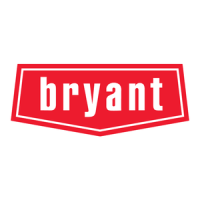
Do you have a question about the Bryant 580J*04--12 and is the answer not in the manual?
| Model | 580J*04--12 |
|---|---|
| SEER Rating | Up to 17 |
| Refrigerant | R-410A |
| Stages | 1 |
| Efficiency | High |
| Operating Voltage | 208/230V |
| Phase | 1 |
| Sound Level (Outdoor) | 72 dB |
| Compressor Type | Single Stage |
Installation and servicing of AC equipment requires trained personnel for safety.
Explains safety-alert symbol and signal words like DANGER, WARNING, CAUTION.
Warning about flammable vapors and gas leak procedures.
Lists monthly/quarterly checks and seasonal maintenance tasks.
Lists tasks for seasonal checks like fan motor bolts, compressor bolts.
Details on return air filters and outside air screens, cleaning and replacement.
Checking belt condition, tension, and replacement procedures.
How to adjust the motor pulley for fan speed changes and pulley alignment.
Steps to adjust the motor pulley to change fan speed.
Recommendations for routine cleaning of condenser coil surfaces to maintain operation.
Details on using Totaline coil cleaner for effective and safe coil cleaning.
Step-by-step procedure for cleaning the evaporator coil.
Information on refrigerant charge amount and procedures.
Information on compressor oil type and handling due to its hygroscopic nature.
How to check and correct compressor rotation direction for 3-phase units.
Lists causes and remedies for compressor and fan not starting.
Lists causes and remedies when compressor won't start but fan runs.
Lists causes and remedies for compressor cycling issues.
Lists causes and remedies for continuous compressor operation.
Primary function of the smoke detector system is to shut down the unit.
Procedure to test the sensor's ability to signal an alarm state using a magnet.
Procedure to test the controller's ability to initiate and indicate an alarm state.
What happens when the smoke detector signals an alarm state.
Conditions that lead to the smoke detector entering a trouble state.
Details on compressor overcurrent, overtemperature, high pressure, and low pressure protection.
Information on the temperature switch for evaporator freeze protection.
Protection devices for the supply fan motor, including internal and Thermix types.
Overview of the heat exchanger system, burners, and safety switches.
Inspecting main burners for deterioration or blockage at the start of heating season.
Procedure for adjusting gas valve pressure settings for heating.
Unit ignition system, IGC, and LED error code interpretation.
Lists causes and remedies for burners failing to ignite.
Lists causes and remedies for insufficient heating performance.
Lists causes and remedies for improper burner flame characteristics.
How outdoor dry bulb temperature controls damper position for free cooling.
Setting outdoor enthalpy changeover using potentiometer for cooling.
Using two enthalpy sensors for differential enthalpy control for cooling.
Using IAQ sensor for demand control ventilation based on CO2 levels.
How DCV operates and how to set damper positions for ventilation.
Important safety warnings and checks before unit start-up.
Checking gas piping for leaks before operating the unit.
Procedure to verify correct compressor rotation direction for 3-phase units.
Steps to start the unit in cooling mode and check refrigerant charge.
Verifying burner ignition, heating controls, and fan operation.
How DCV strategy operates with CO2 sensors to control dampers.
Breakdown of the model number to identify unit specifications.
Physical data for refrigeration system components like circuits, charge, oil, and pressures.
Electrical data for 3-ton units, including voltage, RLA, LRA, FLA, and IFM specs.
Electrical data for 4-ton units, including voltage, RLA, LRA, FLA, and IFM specs.
Electrical data for 5-ton units, including voltage, RLA, LRA, FLA, and IFM specs.
Electrical data for 7.5-ton units, including voltage, RLA, LRA, FLA, and IFM specs.
Electrical data for 6-ton units, including voltage, RLA, LRA, FLA, and IFM specs.
Electrical data for 8.5-ton units, including voltage, RLA, LRA, FLA, and IFM specs.
Electrical data for 10-ton units, including voltage, RLA, LRA, FLA, and IFM specs.
Fields for model number, serial number, date, and technician.
Checklist of pre-start-up inspections and verifications.
Section for recording electrical and temperature readings during start-up.
Section for recording pressure readings and verifying system parameters.
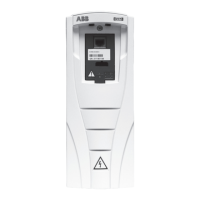





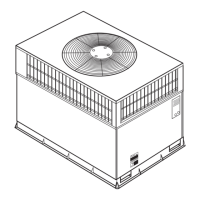
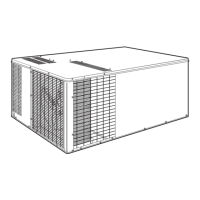
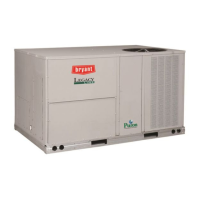

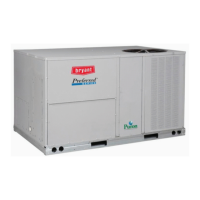

